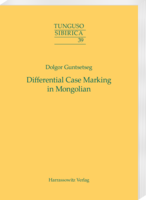|
weitere Titel zum Thema:
Download:
Bitte beachten Sie: Mit digitalen Produkten in Ihrem Warenkorb
wird die Bezahlung nur per PayPal möglich. Der Download dieser Produkte wird bereitgestellt, wenn die Bezahlung bestätigt ist. Mongolian is an ordinary DOM (Differential Object Marking) language: the accusative case does not always occur on direct objects. This book investigates the phenomenon starting from the research question of how the Mongolian pattern is influenced by factors that cross-linguistically trigger DOM, such as referentiality, animacy, and topicality. It shows that looking at any of these factors on its own is not sufficient, but rather that DOM emerges from a complicated interaction of these factors. Apart from DOM, Mongolian also exhibits a specific type of Differential Subject Marking (DSM), in which the subjects of embedded clauses (including adverbial clauses) occur with the accusative case. This is the second issue investigated in the study. In addition to the features already mentioned, sentence structure turns out to be relevant here. More specifically, the adjacent occurrence of main and embedded subjects is identified as a crucial factor for triggering DSM. Both observations about DOM and DSM in Mongolian can be brought together in the generalization that the accusative case in Mongolian is used to distinguish between two arguments not only within a clause but also across the clause boundaries. The book provides a detailed introduction into relevant components of Mongolian grammar, and its findings are supported by extensive experimental studies with a large number of native speakers in an attempt to ensure a high quality of linguistic evidence.
|
|||||||||||||||||||||||||||||||||||||||






